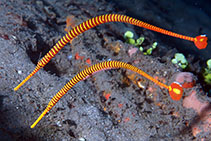| Family: |
Syngnathidae (Pipefishes and seahorses), subfamily: Nerophinae |
| Max. size: |
16 cm TL (male/unsexed) |
| Environment: |
demersal; marine; depth range 1 - 44 m |
| Distribution: |
Western Central Pacific: Known off Sulade Islands in the Sulu Archipelago (Ref. 5316). Eastern Indian Ocean: Australia (Ref. 75154). |
| Diagnosis: |
Dorsal soft rays (total): 30-30; Anal soft rays: 4-4. Description: Characterized by alternating dark brown and pale yellow bands; caudal fin red with large yellow central spot, white upper margin; 10 caudal rays; rings 17 + 20; discontinuous superior trunk and tail ridges; inferior trunk ridge end on anal ring; lateral trunk ridge confluent with inferior tail ridge; length of snout 1.5 in head length; depth of snout 10.5 in snout length; head length 3.8 in SL (Ref. 90102). |
| Biology: |
Adults prefer muddy substrate and usually seen by divers in deep waters that are not disturbed by waves, but it enters shallow estuaries. Adults form pairs and usually swim along the bottom around large remote coral heads on mud slopes. Ovoviviparous (Ref. 205). The male carries the eggs in a brood pouch which is found under the tail (Ref. 205). An active cleaner (Ref. 48635). Solitary or pairs around isolated coral patches on sand/mud slopes (Ref 90102). |
| IUCN Red List Status: |
Least Concern (LC); Date assessed: 24 February 2015 Ref. (130435)
|
| Threat to humans: |
harmless |
| Country info: |
|
Source and more info: www.fishbase.org. For personal, classroom, and other internal use only. Not for publication.

